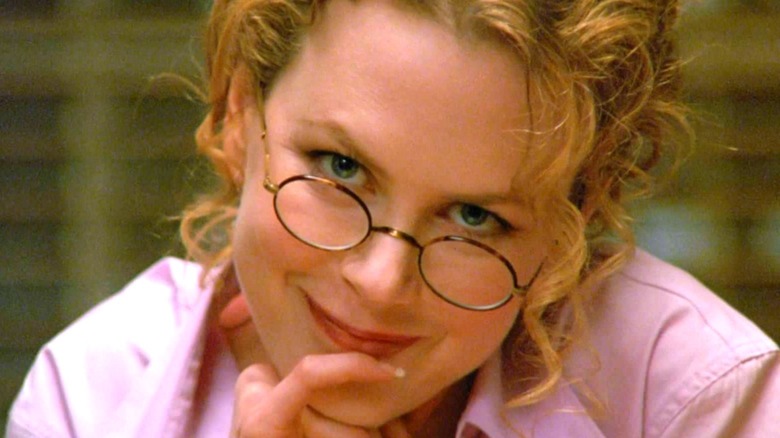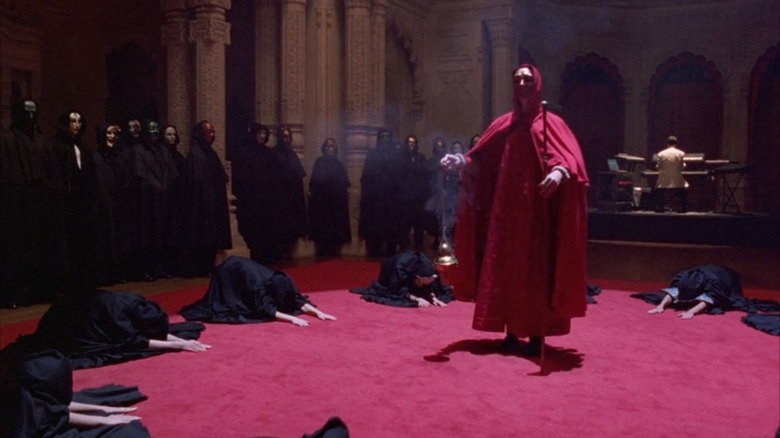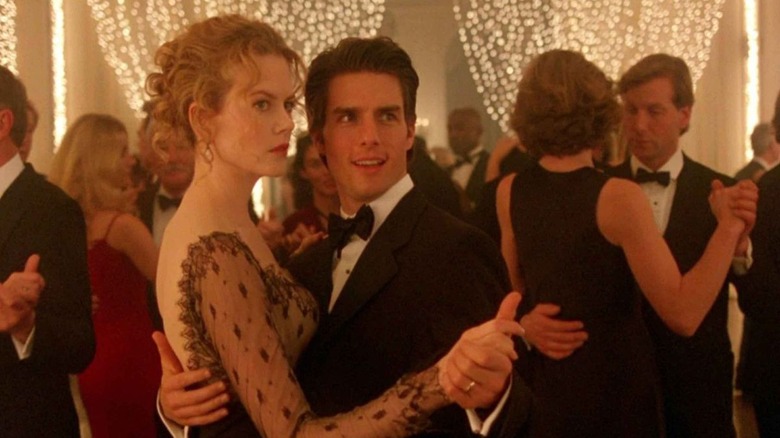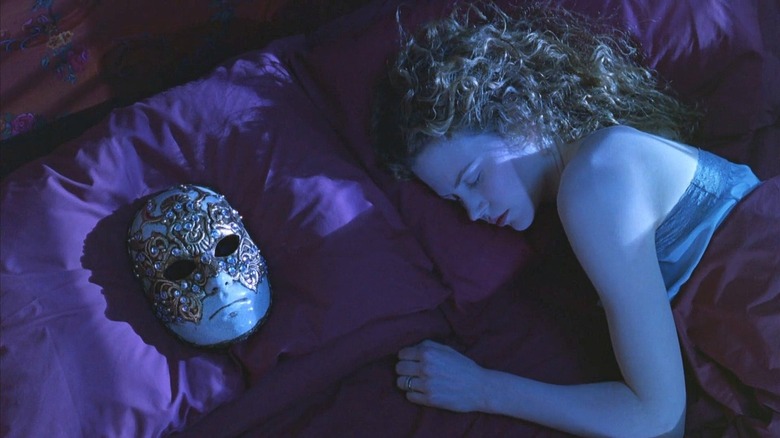The Ending Of Eyes Wide Shut Explained
1999 was a busy year for a lot of reasons. Facing the centennial, there was a lot to look forward to, and a lot to leave behind. For director Stanley Kubrick, there was one film idea that he just had to finish before the year was over, and that was "Eyes Wide Shut." The movie is based on a German novella from 1926 called "Traumnovelle," or "Dream Story," which focuses on a man in Vienna who finds out his wife has fantasies of other men, and goes on a two-day journey dealing with personal realizations about sex, individualism, and morality.
For Kubrick's film, he transferred the story from early 20th century Vienna to New York City, Greenwich Village specifically, in the 1990s. The director cast Tom Cruise and Nicole Kidman, husband and wife at the time, as the main couple in the story named Bill and Alice. The movie began filming in November 1996 and ended in June 1998, holding the Guinness World Records for longest constant movie shoot at over 15 months, with 46 weeks of unbroken shooting.
The film is a confounding story, and even two decades later, fans and critics alike continue to debate the meaning behind "Eyes Wide Shut" and whether the final cut was what Kubrick really wanted.
The themes and meaning of Eyes Wide Shut
While Kubrick's other films explore topics like free will, conformity, and class privilege, "Eyes Wide Shut" takes on society's dehumanization of sex. For Bill and Alice, sex and temptation is all around them, but they only have eyes for each other. But one night Alice admits that she considered having an affair with a handsome naval officer a year earlier, and Bill's whole world is turned upside down. He then begins a night-long journey to explore and possibly give in to his own temptations, stumbling upon a secret society participating in a masked orgy.
The story is strange and winding, adding to the dreamlike quality of filmmaking that takes influence from the original "Dream Story." Throughout the night, Bill meets various strangers who attempt to engage him in sex. While he almost gives in a few times, he makes it through the encounters unscathed until he gets to the main event, the secret society's weird orgy. With this film, Kubrick is taking on "the causes and effects of depersonalized sex." One early review of the film describes the orgy scene as "the fulcrum" of "Eyes Wide Shut," saying, "sex is normally the most intimate means of human interaction, yet here it is reduced to a ritualistic, almost creepy form of gratification ... There is freedom in anonymity, but also isolation and a complete dearth of emotion" (Reel Views).
After this encounter, Bill finally realizes the dark side of this world of sex and anonymity, returning to his wife Alice's side. She is still open with him about her past sexual fantasies, but in the end they stay loyal to each other, happy that their marriage and mutual sexual attraction have survived this long.
The crazy process to make Kubrick's last movie
It's safe to say that Kubrick had a reputation for being quite the demanding and unusual filmmaker. Although many people are familiar with his abuse of Shelley Duvall on the set of "The Shining," some might not know just how crazy it was to make "Eyes Wide Shut," the director's last film.
Along with how long it took to film the movie, Kubrick put his main two actors through a lot of intense experiences. The director took take after take of the same scene, but not because he had a detailed vision in mind. According to a Vanity Fair article detailing the film's production, his "theory was that once his actors bottomed-out in exhaustion and forgot about the cameras, they could rebuild and discover something that neither he nor they expected." Kubrick also never let his actors see any daily footage, and this inability to track his own performance across the film gave Cruise an ulcer, which he hid from Kubrick.
The director also thoroughly blended fact and fiction, creating a feeling of distrust between Cruise and Kidman by choosing to "direct each actor separately and forbid them to share notes. In one painful example, for just one minute of final footage where Alice makes love to a handsome naval officer—an imaginary affair that haunts Bill over the course of the film—Kubrick demanded that Kidman shoot six days of naked sex scenes with a male model ... He banned Cruise from the set and forbade Kidman to assuage her husband's tension by telling him what happened during the shoot." The emotional abuse he put his actors through was apparently worth it for them, but it's up to debate whether or not it improved the final product.
Debate and censorship for Eyes Wide Shut
"Eyes Wide Shut" is Kubrick's final film before his death. According to the documentary "Stanley Kubrick: A Life in Pictures," Kubrick was in the middle of post-production when he showed what Warner Bros. executives claim was a relatively final cut of the film on March 1, 1999. The director died six days later, on March 7, 1999, at the age of 70. "Eyes Wide Shut" opened on July 16, 1999, and did well at the box office and with critics. It currently holds a 75% on Rotten Tomatoes. But that doesn't mean that there isn't any controversy attached to the film's release.
Firstly, the movie had to be censored to hit the R-rating, with the orgy scene taking a large hit. According to a 1999 New York Times article, "65 seconds of the movie were digitally altered. Essentially, shrouded digital figures were placed in front of couples engaged in sex, partly blocking the audience's view." At the same time, some people argued that "Eyes Wide Shut" was an unfinished film, and the final product was not the one Kubrick intended to release. A frequent collaborator of Kubrick, writer Michael Herr, revealed in a Vanity Fair piece that Kubrick called him shortly before he had to show the Warner Bros. executives a cut the film, saying that "there was looping to be done and the music wasn't finished, lots of small technical fixes on color and sound; would I show work that wasn't finished?" He was forced to show the executives due to contractual reasons but didn't want to, and this was likely the cut that later became the final product.
While there's a lot of interesting history and questions revolving around "Eyes Wide Shut," unfortunately Kubrick isn't around to clarify anything. Still, the director's final film impresses as an unforgettable story about morality and sexuality, no matter what way you look at it.



